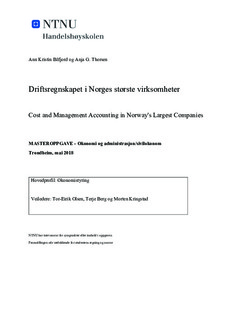| dc.contributor.advisor | Olsen, Tor-Eirik | |
| dc.contributor.advisor | Berg, Terje | |
| dc.contributor.advisor | Kringstad, Morten | |
| dc.contributor.author | Båfjord, Ann Kristin | |
| dc.contributor.author | Thorsen, Anja G. | |
| dc.date.accessioned | 2018-12-06T13:45:44Z | |
| dc.date.available | 2018-12-06T13:45:44Z | |
| dc.date.issued | 2018 | |
| dc.identifier.uri | http://hdl.handle.net/11250/2576442 | |
| dc.description.abstract | Driftsregnskapet har lenge blitt kritisert for å ikke levere presis og tilstrekkelig informasjon i raskt endrende omgivelser. For å takle utfordringene knyttet til driftsregnskapet ble det, med bakgrunn i kritikken, promotert en rekke «moderne» økonomistyringsverktøy. Likevel er driftsregnskapet en viktig del av den økonomiske utdannelsen ved høyskoler og universiteter. Formålet med denne masteravhandlingen er å kartlegge norske virksomheters bruk av driftsregnskapet og undersøke om det er samsvar mellom teori og praksis på området, samt undersøke hvilke faktorer som påvirker bruken av driftsregnskapet. Dette undersøkes gjennom følgende problemstilling:
«Hvor utbredt er driftsregnskapet i Norges 500 største virksomheter, og hvilke faktorer påvirker bruken av driftsregnskapet?»
For å besvare problemstillingen gjennomførte vi en spørreundersøkelse hvor totalt 108 økonomiansvarlige, på vegne av deres virksomhet, har besvart. Resultatene viser at Norges største virksomheter benytter driftsregnskapet i stor til svært stor grad. Av verktøyene innenfor driftsregnskapet er det avviksanalyse som i størst grad blir brukt, og da spesielt i forbindelse med kostnadskontroll og lønnsomhetsanalyse. De andre verktøyene (selvkostmetoden, bidragsmetoden, ABC, standardkostregnskap og normalkostregnskap) benyttes i relativt liten grad. Regresjonsanalysen indikerer at det er en signifikant sammenheng mellom virksomhetens størrelse, bransje og kostnadsstruktur, og bruken av driftsregnskapet. Det samme gjelder virksomhetenes opplevde konkurranseintensitet i markedet og virksomhetens strategi. Resultatene viser altså at faktorer knyttet til virksomhetens omgivelser og karakteristika ved virksomheten henger sammen med bruk av driftsregnskapet, og kan anses som et viktig bidrag til betingelsesteorien. Regresjonsanalysen viser også at det ikke er noen motsetning mellom bruken av «tradisjonelle» og «moderne» styringsverktøy, noe som står i strid med kritikken av driftsregnskapet. | nb_NO |
| dc.description.abstract | Abstract
Cost and management accounting has for a long time been criticized for the inability to deliver accurate and sufficient information in rapidly changing environments. Based on these criticisms, several «modern» management accounting tools have been developed to cope with the challenges related to cost and management accounting. Yet, cost and management accounting is an important part of the economic education at colleges and universities. The purpose with this master thesis is to explore the extent of use of cost and management accounting in Norwegian companies, to describe the factors that affect its use, and examine whether there is a correlation between theory and practice. The study will address the following research question:
«How prevalent is cost and management accounting in Norway’s 500 largest companies, and which factors affect the use of cost and management accounting?»
In order to answer this research question, a survey has been conducted, where a total of 108 financial managers participated. The results of the study show that Norway’s largest companies use cost and management accounting in a high extent. Variance analysis is the most used tool, particularly regarding cost control and profitability analysis. The other tools (full costing, the contribution method, activity-based costing, standard costing and normal costing) are used in a relatively small extent. The study show that factors related to the companies’ environment and the characteristics of the company is connected to the extent of the use of cost and management accounting. The regression analysis indicates that there is a significant relation between the size, industry and cost structure of the company, and the use of cost and management accounting. The same applies to the companies’ perceived intensity of market competition and strategy. These findings are considered as valuable contributions to contingency theory. The regression analysis also shows that there is no inconsistency between «traditional» and «modern» management accounting tools, and therefore contradict the criticism of cost and management accounting. | nb_NO |
| dc.language.iso | nob | nb_NO |
| dc.publisher | NTNU | nb_NO |
| dc.title | Driftsregnskapet i Norges største virksomheter - Cost and Management Accounting in Norway's Largest Companies | nb_NO |
| dc.type | Master thesis | nb_NO |
| dc.subject.nsi | VDP::Samfunnsvitenskap: 200::Økonomi: 210::Bedriftsøkonomi: 213 | nb_NO |
